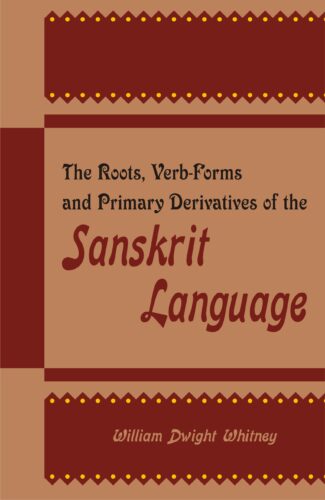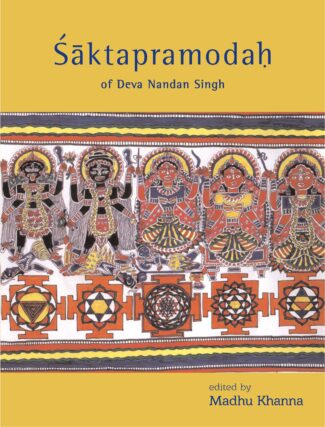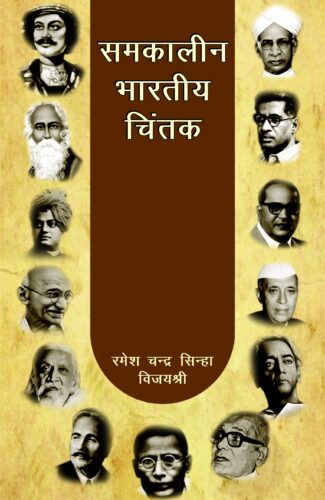Showing 241–250 of 384 results

The volume speaks about the civilisational dimensions of religion and culture in India, unity and diversity of Indian civilisation, idea of civilisation, ecological crisis in the modern world, relationship between tribal and non-tribal religions, religious philanthropy, Christian influence on Hindu way of life in India, and concept of composite culture of India.
The volume deals with the civilizational dimensions of religion and culture in India. It underlines the point that religion and culture are important elements of all civilizations but it is their interplay that has given a unique feature to Indian civilization.
The essays interrogate the various western sociological discourses on civilization and articulate the alternative conceptualizations available in Indian sociology. They underline the unity and diversity of Indian civilization, present the idea of civilization as conjoined with the idea of civil society and study the ecological crisis in the modern world. They focus on the dialogical relationship between tribal and non-tribal religions, link between religion and environment, religious philanthropy and Christian influence on Hindu way of life in India. They also delve into the concept of composite culture in India, scrutinising aspects of folk religion and cultures to show, for instance, how art forms get accumulated into the idea of culture.
The volume will be of immense interest to a variety of scholars and students associated with the study of Indian religion and culture.

This, an authorised reprint of an annual bulletin of the Indian Archaeological Society, has been offering valuable informations, full with rich insights and innovative viewpoints, on the Indian archaeology that includes excavations, inscriptions, temples, mosques, iconic symbols, paintings, etc. This yearly bulletin is highly recommended for archaeologists, epigraphists, historians and research scholars besides the general readers having interest in such fields.
Ancient Indian polity took a new turn with the emergence of republics in the post-Vedic age. The history of republics covers the period from the age of the Mahabharata to the fourth century AD. Dr. G.P. Singh here comprehensively, yet incisively, studies the rise, growth and fall of republics in ancient India during the period. He has also dwelt upon the rise and expansion of kingdoms and growth and decline of towns, cities and various urban centres in different parts of the Indian subcontinent at length. The work traces the pattern and functioning of republican governments at the time of the Buddha (sixth and fifth centuries bc) Panini (fifth century bc), Kautilya (fourth century bc), Alexander (327-325 bc), the Mauryas (321-184 bc) the Sungas (184-72 bc) and the Guptas later. The research is based on the indepth study of the epics, the Puranas, and Buddhist and Jaina sources which are supplemented by Greek and Roman writings, Sanskrit literary evidence and epigraphic & numismatic discoveries. It delves deep into modes of expansion of territories, factors leading to urbanisation and urbanisation patterns, and town planning. It presents a picturesque description of the urban centres of north-western India primarily based on Greek and Latin sources and pays special attention to dates related to founding of republics and cities, their extent, their functioning as administrative and religious centres, the problem of their identification and references to them in works, and their place in the wider framework of ancient Indian polity. The book will be useful to scholars and students interested in the study of ancient Indian polity and urban history.

This interesting compendium highlights the importance and stature of women Rishikas in the Vedic literature as epitomes of spiritual attainments, and emphasises that the gender discrimination as seen in the Hindu traditional thought was a later phenomenon. It provides a list of women Rishikas and mantras envisioned by them.
The volume presents a study of the famous women Rishikas mentioned in the Vedic literature.
The book describes the great respect offered to seers in the Vedic literature and the equal importance given to Rishikas when compared to Rishis. Discussing how even women of the Vedic period were epitomes of spiritual attainment, the book admiringly points out that the gender discrimination seen in the Hindu traditional thought was a later phenomenon (such as that women are not adhikaris for the study of the Vedas). It states that there are twenty-seven women mantra-drashtarah in the Rigveda. It provides a list of these women Rishikas and deals with the mantras envisioned by them. The Rishikas are mentioned in the study on the basis of those who praised the deities, those who conversed with the seers and deities, and those who praised the self. The Rishikas mentioned in the Yajurveda, Samaveda, and Atharvaveda are also mentioned. Rishikas whose individual contributions are taken up in detail include Vagambhrni, Surya-Savitri, Shraddha, Daksina, Aditi, Ratri, and Urvashi, among others.
The volume is bound to be a handy reference book for all those interested in Indology, particularly students and scholars of Vedic and gender studies.

It looks into specific cultural formation of Teyyam. It re-frames and interprets various myths of mother-goddesses and hero-deities by situating them in the historical conditions in which they originated and explores from a sociological perspective how the ritual functions as ideology.
Teyyam, the spectacular ritual dance widely performed in north Kerala, has its distinct forms of visual and verbal expression. However, what was once expressed through the distinctly indigenous forms of this religious other no longer remains the same, as the specificities of meaning and messages as encoded in the whole structure of its ritual performance were levelled out and superceded by the ideological laundering of caste Hinduism. RITUAL AS IDEOLOGY looks into the specific cultural formation of teyyam it re-frames and interprets various myths of the mother-goddesses and hero-deities by situating them in the historical conditions in which they originated. Based on a study of the myths at a micro-structural level, the book explores from a sociological perspective how the ritual functions as ideology, apart from its cultic or religious significance. The study also unfolds and explains the gender disparity between the archetypal Female Devourer and her Male Victims, the recurrent motifs in the myths related to various manifestations of the Terrible Mother in teyyam. The study thus acquires contemporary significance in the face of cultural authoritarianism that in its design of appropriation attributes the village pantheon of every little tradition to canonical Hinduism, a process that has been so rife in todays cultural politics.

Exhaustive in nature and giving authentic information, this work is a thesaurus in its own kind, respecting the Sanskrit language of every age. It covers the periods in the life of the language, acknowledging and distinguishing it with different notations.
The book is intended especially as a supplement to Sanskrit Grammar of W.D. Whitney and includes all the views comprehensively of a given root in the Sanskrit language. The author has respected the language of every period, and the great St. Petersburg Lexicon of Böhtlingk and Roth have been his greatest source for materials on epic and classical literature. In the older language of Vedas and Brahmanas and Upanishads and Sutras, he has done much more independent work. The periods in the life of the language which are acknowledged and distin- guished by appropriate notation are six: the Veda (v.); the Brahmana (b.); the Upanishads (u.); the Sutras (s.); the epics (e.); and the common Sanskrit (c.). They have all been adequately explained in detail. The book will be useful to the scholarly community in need of authentic information on Sanskrit language.

The book studies the outstanding features of 31 famous palaces, pavilions and residences of the ruling class in different parts of Medieval India, from the thirteenth to the eighteenth century. It illustrates and discusses the layout plan of each building in detail.
The book brings out the outstanding features of the palaces, pavilions and residences of the ruling class in medieval India from the 13th to the 18th century. The focus is on structures that represent a group on religious and ethnic lines, i.e. Hindu/Islamic rulers, Indo-European Hindu or Dravidian Hindu or Afghani or Turk or Iranian rulers, and structures characteristic of particular periods and locales. Presenting some 31 famous buildings including the City Palace of Udaipur and Jaipur and the Lal Qila, Delhi and pleasure pavilions like the Hauz Khas, Delhi and Farah Bagh, Ahmadnagar, the work studies palaces and pavilions from the different regions of India. It illustrates the layout plan of each building in detail. Dr. Fredrick W. Bunce discusses the size, elaborateness or luxury of the royal structures which underlined the kings right to rule. With elaborate notes, he showcases their characteristics such as their tendency towards axiality and their symmetrical aspect, the Hindu rulers choice of the immutable square for the plan and their reliance on the shilpa-shastras, the east-west alignment of the structures, the labyrinthine character of residences/palaces, and their iconography that is unique to the Indian subcontinent. The volume has appendices that give the plans of other great structures of India and the world, list the major rulers of kingdoms in Indias different regions and provide a chronological list of major Indian monuments. The book will be extremely useful to students and scholars of Indian cultural history, particularly relating to architecture and iconography.

This book offers a study of Bhartrharis Vakyapadiya in an altogether modern (the post-Fregean) perspective on the philosophy of language. Bhartrharis analysis of language is presented methodically and in contemporary philosophical idiom.
It is the first ever study of the fifth-century scholar, Bhartriharis Vakyapadiya in an altogether modern, the post-Fregean, perspective on the Philosophy of Language. A uniquely original thinker in Indias splendid grammarians tradition, Bhartrihari overreached the limits of language analysis set by his predecessors like Panini and Patanjali constructing, as he did, a brilliant Philosophy of Language that sought to spell out, among other aspects, the subtle distinctions between the knowable and the sayable, between what is said and what is meant, between the semantics of everyday speech and literary discourse. Sadly, Bhartrihari has, through the centuries, suffered neglect, largely because the Grammarian School never figured in the six major systems of traditional Indian philosophy.
For the first time, this monograph tries to reinterpret Bhartriharis position as a philosopher, emphasizing the high relevance of his Vakyapadiya to modern Western thought. A reputed scholar of grammar, philosophy and Sanskrit studies, the author presents Bhartriharis analyses of language methodically, unbiased. And, significantly, in contemporary philosophical idiom with contextual focus on the views of modern Western philosophers: Frege, Wittgenstein, Grice, Austin, Davidson, Searle, Strawson and the like. Also offered here is a lucid exposition of the Sphota Theory.
Growing from Dr Patnaiks a decade-long research on Bhartriharis philosophy, the volume highlights not only ancient Indian contribution to the study of language, but the interconnectedness among its indigenous approaches to linguistics, philosophy, logic and aesthetics as well.

What is the doctrine of Sabdapramana (word as knowledge)? What is involved in hearing words? Is the understanding (Sabdabodha) derived through hearing utterances direct or indirect? Or does it depend on certain other conditions for its validation? These are just some of the questions that have emerged within the Hindu philosophical tradition which this book tries to answer.
Shabdapramana or Testimony is a formidable doctrine within Indian philosophy. A thorough investigation of this thesis is long overdue. What is shabdapramana (word as knowledge)? What is involved in hearing words? Is the understanding derived through hearing utterances direct or indirect? Does this peculiarly linguistic understanding (shabdabodha) amount to knowledge (prama), or does it depend on certain other conditions for its truth? Further, what sort of theories of meaning, understanding, and knowledge would be required to ground a successful shabdabodha as prama,> need careful attention. It is sometimes said that Indian thinkers had no particularly interesting theory of understanding. The present work sets out to address these issues issues that have engaged traditional and modern thinkers alike. Based on the classic text, Advaita Vedanta-paribhasha of Dharmarajadhvarindra (17th century), the analysis and arguments extend to the views of and criticisms from the Nyaya, Purva Mimamsa and the grammarian/linguistic schools within Indian philosophy, with a treatment of similar concerns in Western philosophy. There is a compelling thesis here that should be taken seriously in any philosophy. Long discarded as a distinct source of knowledge in Western philosophy, Testimony might be fruitfully re-examined. This could lead to mutual dialogue between philosophy and religion, and pave the way for critical metaphysics.

Saktapramoda is a liturgical paddhati-style compendium of sixteen independent ritual manuals. Of the sixteen texts in it, ten are dedicated to the group of ten Great Tantric Mahavidyas and, Kumari Tantra, which is another allied one devoted to the worship of a young maiden (Kumari). The rest are devoted to five deities: Ganesa, Vishnu, Shiva, Durga and Surya.
Shktapramoda of Deva Nandan Singh is a liturgical paddhati-style compendium of sixteen independent ritual manuals. The first ten works, comprising the major part of the text, are dedicated to the group of ten Tantric goddesses, referred to as the Ten Great Mahavidyas or Ten Supreme Powers the goddesses Kali, Tara, Sodashi, Bhuvaneshvari, Chinnamasta, Matangi, Tripurabhairavi, Dhumavati, Bagalamukhi and Kamala. The next important text closely allied to the worship of the goddesses is the Kumari Tantra devoted to the worship of a young maiden (Kumari). The next group of works comprises the pentad of Tantras devoted to five deities: Ganesha, Vishnu, Shiva, Durga and Surya. These five deities are invoked in almost all forms of ritual worship prescribed by the Vedas, Puranas and to a degree by the Tantras.
Each Tantra describes the dhyana of the deity, the yantra, mantras and the method of Tantric form of worship of the deity, along with praise hymns, protective formulas (kavaca) and litanies of divine names, be they a group of hundred names (shatanama) or a thousand names (sahasranama).
The first edition of Shktapramoda was published by Raja Deva Nandan Singh, an aristocratic zamindar of Muzaffarpur, Bihar, in the nineteenth century. The present edition brings together a fully edited and revised text with an elaborate introduction (in English), and a comprehensive index along with lithographic images of Tantric deities.

Phiolosophical thoughts of modern Indian thinkers are quite comprehensive. While they are conversant with the Vedas, Upanisads and the Quran, they are also quite known to the Western thoughts. Philosophical thoughts of Raja Rammohun Roy, Tagore, Vivekananda, Mahatma Gandhi, Sri Aurobindo, Iqbal, K.C. Bhattacharya, S. Radhakrishnan, M.N. Roy, Ambedkar, Jawaharlal Nehru, J. Krishnamurty and Loknayak Jayaprakash Narain are streamlined and discussed.
This is the age of enlightenment. The contemporary Indian thinkers accept and practise the old values, traditions, and have paved the way for a new thought process in philosophy. And this philosophy is the product of an age of India’s struggle against long and suppressive foreign rule, hampering the growth of our thought system. However, one could see a new synergy in post- independent India a philosophical renaissance. In such a background, these thinkers propose positive, synthetic and integral world-views.
The thoughts of contemporary thinkers are quite comprehensive and exhaustive because they are well aware of the Vedas, Upanishads and the Quran. On the other hand, modern Indian philosophers have reconciled between the Western and Eastern, and the ancient and modern thoughts. This volume streamlines the thoughts of Rammohun Roy, Rabindra Nath Tagore, Vivekananda, Mahatma Gandhi, Sri Aurobindo, Iqbal, K.C. Bhattacharya, Sarvepalli Radhakrishnan, M.N. Roy, Bhim Rao Ambedkar, Pandit Jawaharlal Nehru, and J. Krishnamurty.
It makes this book a good reading for the teachers and students of modern Indian philosophy, detailing the philosophical perspectives of popular modern Indian philosophers.
| There are no products |